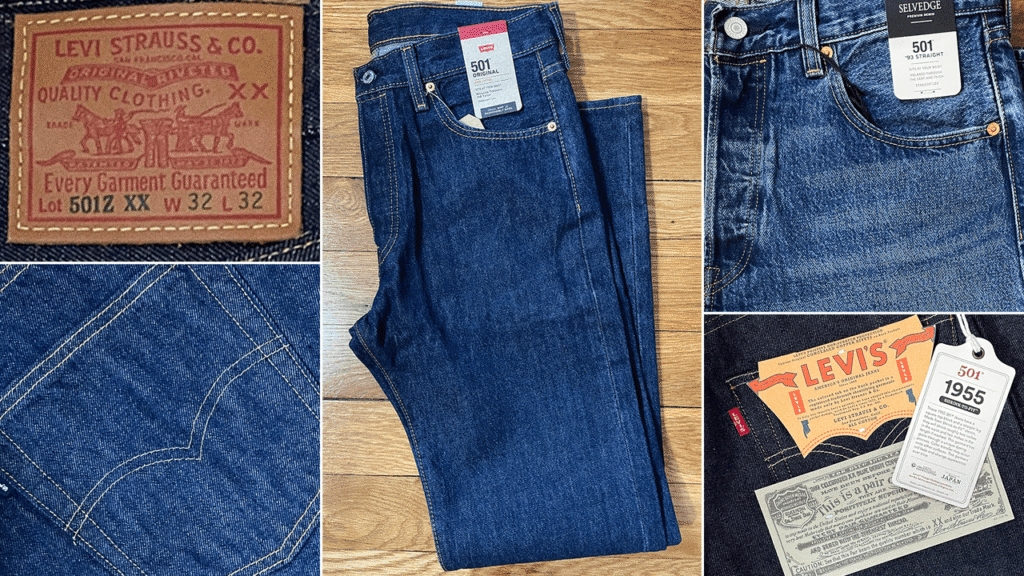The squarer, more relaxed shape also set the stage for future roomy hits like the 555 or 568. No ’55, no baggy jeans era. And then what would skateboarders, grunge kids, and 2000s rappers have worn?
The Unsung Fit: Levi’s Vintage Clothing 1966 501
This particular fit burned bright and faded fast. The 501 left its bad-boy era behind with a return to a slimmer fit, this time with a more pronounced taper from thigh to leg opening. The denim got lighter and softer, too. The look a little more preppy, particularly today. Jeans had arrived outside of the blue collar world.
To complete the 501’s house training, Levi’s jettisoned the hidden rivets on the back pockets for bar tacks. Cleaner, smoother, less likely to scratch your shiny new Pontiac GTO’s paint. Now, denimheads consider originals from this era—1966 to 1971—the last of the “classic” 501s, since they had the final big-E red tabs and single-needle stitching. With the LVC reproductions, though you get to keep the Golden Age alive.
The Most Relaxed: Levi’s Vintage Clothing 1937 501
The original versions of these 501s were game-changers when they arrived just after the Depression: the back pocket rivets were hidden, the now-iconic Red Tab made one of its earliest appearances, and suspender buttons were replaced with belt loops. Levi’s tossed in a free pair of suspenders with every 501 purchase in 1937, though, because they were considered denim training wheels for newcomers. Which is ironic, since nowadays, the Levi’s Vintage Clothing 1937 501s feel like they’re more for the purists.
For one, there’s the old-timey waist cinch out back—a vintage hit if ever there was one. For another, while the silhouette remains devoutly straight-leg, it’s significantly roomier from the thigh down than any of the other pairs here. At a size 32, the 1937’s knee opening is 1.75” bigger than the Original 501’s; the leg opening is two inches bigger.
What you get is a 501 that’s probably best paired with more denim, a pair of heavily cooked boots, and a lunchpail.
The Stripped-Down Throwback Fit: Levi’s Vintage Collection 1944 501
I think the 1944 501 has one of the best backstories and one of the most slept-on fits in denim history. The originals dropped right in the middle of World War II, when the U.S. government basically told every clothing manufacturer to start rationing metal, fabric, and thread. Levi’s obligingly stripped down the 501, losing the watch pocket, crotch rivets, and the entire cinch, while also swapping in the no-frills laurel leaf buttons.
The toughest cut, though? The signature looping arcuate stitching across the back pocket that made Levi’s instantly recognizable as America’s jeans. Levi’s problem-solved by printing on the “stitching”—which would wear off over time.
These days, the Levi’s Vintage Clothing 1944 501 still delivers on its Depression-era simplicity while also featuring a baggier seat, a higher rise, and a slightly looser cut than the bog-standard 501. There’s something nice about wearing them so much that the printed stitching disappears, but the Red Tab still waves proudly. Genius-level design, born out of wartime necessity.
Why Are You Here?: Premium 501 Slim Taper
Of the 17 pairs of 501s Levi’s sent me, there are some shrugworthy styles I couldn’t get excited about, like the supposedly moisture-wicking yet insulating 501 Thermoadapt, and the slightly airier 501 Lightweight. But the Slim Taper? Hard pass.
A slim, tapered 501 makes as much sense as GoreTex flip flops. Even through 135 years of nips and tucks, Levi’s signature pair has always remained a straight-leg icon. This version—snug through the thigh, with a fairly aggressive taper, and some stretch to make it all work—tosses all that out the window. I understand the impulse to just slap “501” on the tag and take advantage of name recognition, but this fit feels confused and unsatisfying. Especially since, if you want some taper, Levi’s has plenty of other great options like the 502, the 514, and the legendary 505.














